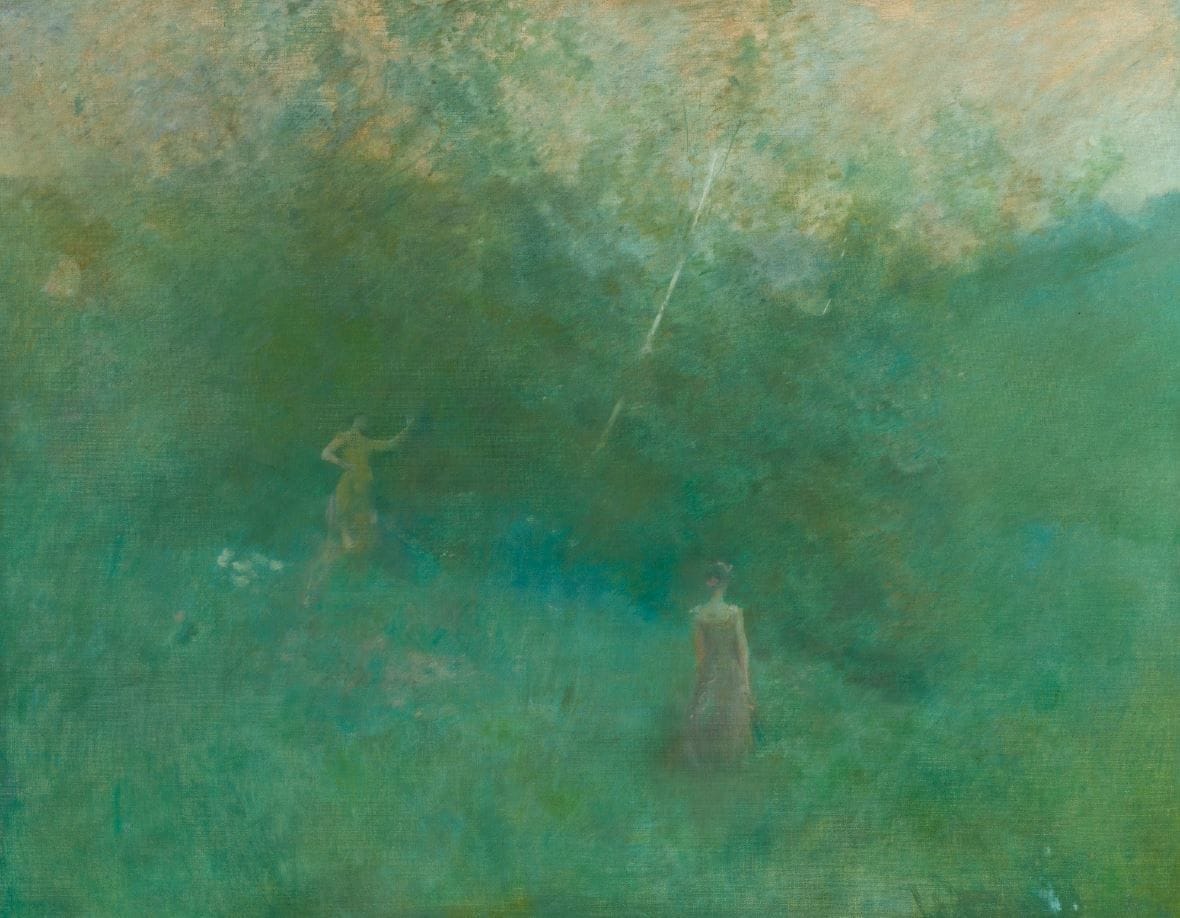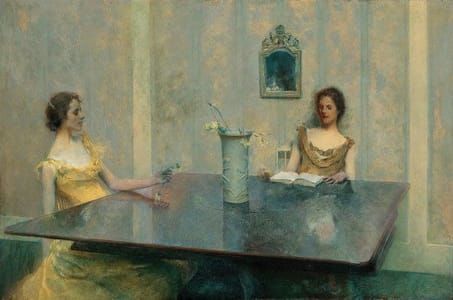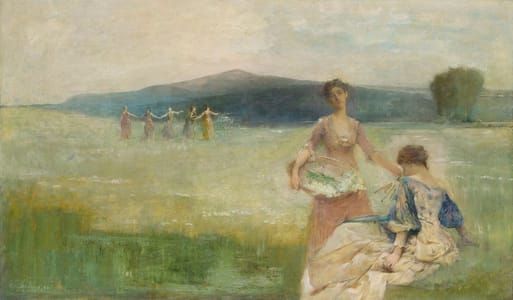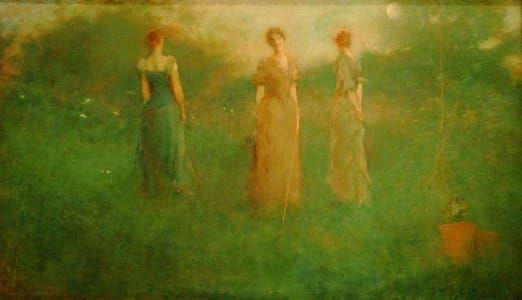

The White Birch, 1899
Thomas Wilmer Dewing
A sophisticated masterwork of Thomas Wilmer Dewing’s oeuvre, The White Birch manifests all of the best qualities of his art from the period. Works such as this compelled the critic Charles H. Caffin to proclaim that Dewing was “the most remarkable of modern painters…he works like a musician to a symphonic scheme; and the harmony of his pictures, so rhythmic, vibrating, and melodious, affects one in the way of stringed music… interpreting to one’s capacity for intellectual sensuousness the most exquisite suggestions of form, tone, and texture.”
Here Dewing elegantly combines a variety of diverse influences into the unique and inimitable aesthetic that defines his most progressive work. When viewed from the vantage point of the 21st century, The White Birch stands as a testament to Dewing as a visionary whose work from the 1890s presages the development of art in America.
Dewing painted The White Birch following a trip to Europe. Prior to his return, he spent time at the famed French artists’ colony, Giverny, where Monet had his home and gardens, inspiring a number of American and European artists to make a pilgrimage to work in the shadow of the Impressionist master. Unlike many of his peers, Dewing was not compelled by the then popular Impressionist style, choosing instead to work in a more tonal, moody aesthetic. “Rejecting Impressionism, Dewing sought to convey a poetic and imaginative world where, according to the artist, ‘only a few choice spirits live.’” Wanda Corn eloquently distinguishes between the effects of the two stylistic approaches, “While Impressionists dazzled the eye, Tonalists touched the soul.” (“Reflections on ‘The Color of Mood’” in Marc
The White Birch is one of a group of large-scale landscapes Dewing painted while in the artists’ colony of Cornish, New Hampshire, where he and his wife, Maria summered from 1895 to 1905. These works, of which The White Birch is exemplary, wonderfully assimilate disparate influences into his own distinctive style. These include the work of James McNeill Whistler, whose studio Dewing visited in 1894 with their shared patron, Charles Lang Freer. Dewing stayed on to paint with Whistler from December through March of the following year and they shared a great mutual respect for one another’s work. Dewing referred to works such as The White Birch as “decorations” much as Whistler referred to his paintings as “harmonies,” “symphonies” and “arrangements.” The artists deliberately used these terms to indicate that instead of merely transcribing the scenes before them, they were instead creating sophisticated and progressive compositions that were meditations on the painted surface, the effects of subtle tonal relations and the process of painting itself. Cody Hartley writes that these “decorations,” “overwhelm the eye. Reveling in richly suggestive ambiguity, they appeal to specific sensory responses to heighten the contemplative experience…depth is stymied by the flatness of the painted surface and an indistinguishable horizon line.”
...The White Birch was one of the last works Dewing painting in Cornish and can be seen as the culmination of his visual explorations of the time. This seminal work manifests Whistler’s famed 1885 “Ten O’Clock” lecture, “Nature contains the elements, in color and form, of all pictures, as the keyboard contains the notes of all music. But the artist is born to pick, and choose, and group with science, these elements, that the results may be beautiful—as the musician gathers his notes, and forms his chords, until he bring forth from chaos glorious harmony. To say to the painter, that Nature is to be taken as she is, is to say to the player, that he may sit on the piano.”
Although inspired by the verdant New Hampshire landscape, The White Birch presents an ethereal, spatially ambiguous composition that verges on pure abstraction. Diaphanous washes of oil are juxtaposed with the thick weave of the canvas to create a shimmering surface. Subtle modulations of green, blue and mauve are punctuated by dashes of pink, white and blue, creating a dreamlike and slightly disorienting environment. This disorientation is further heightened by the abstrusely defined horizon line. Dewing’s thoroughly modern approach to the sky seamlessly incorporates exposed canvas with tones of mottled mauve and blue. He masterfully employs equiluminant colors which “have long been recognized by artists as being special because they can generate a sense of vibration, motion, or sometimes an eerie quality.” The White Birch possesses a tremulous surface and quiet luminosity. The landscape is subtly blurred and misty, imbuing the work with a sense of motion – of wind tickling the landscape, ruffling the leaves and long grasses. This causes the viewer’s eye to dance across the surface trying to find a focal point to enter the scene. These efforts are continually rebuffed creating an enduring engagement as The White Birch reveals its pictorial complexity slowly, disclosing something new upon each viewing.
This quivering, enigmatic scene is moored by the visual anchors of the female figures and the slim, elegant trunk of the white birch. This beacon, which is echoed by the arm of the distant figure, juts diagonally through the composition. Dense dashes of blue at lower right, pale grey to the left of the distant figure and pinks along the left edge suggest flowers and function much as the sparks in Whistler’s Nocturne in Black and Gold: The Falling Rocket. Each of these elements is simultaneously separate from and submerged within the amorphous greenery, altering the viewer’s perception and challenging him or her to visually interpret and navigate the spatial ambiguity of the work.
This lyrical, atmospheric painting is tinged with an element of the surreal – two women in evening dress stand sphinxlike in a landscape, not interacting and seeming completely unaware of one another despite their physical proximity. Robert Rosenblum writes¸ “Strangely unprotected in these empty, unlocalized spaces, these figures in contemporary dress seem like wanderers who have left their homes and intruded upon a silent, almost barren territory.” As in other Dewing works from the period including The Recitation and The Song the figures are in contrast, one active, one contemplative. “This psychological opposition only amplifies the ambiguity of the subject: two formally dressed women who inexplicably wade through knee-high grass in a dense, almost oppressive atmosphere.” The psychological alienation of the two figures and unresolved narrative imbues the work with a tension that foreshadows Edward Hopper’s work. In much of Hopper’s work as in The White Birch, the viewer is continually engaged as he or she tries to create or complete a narrative.
Kevin Sharp writes, “A billowing field of shimmering brushwork that Dewing spotted with diminutive and introspective figures, The White Birch stands today as a tribute to a time gone by and to the romance of life in the Cornish art colony. Knowing that his days as a colonist were coming to an end even as he worked on the canvas, Dewing infused it with a feeling of nostalgia coupled with a quality of exultation visible in the gesturing figure whose upraised arm echoes the vigor of the slanting tree.” In addition to a culmination of his artistic explorations and homage to his time in Cornish, The White Birch can also be seen as an important bridge between 18th and 20th century painting that portends the development of art in America. When the painting was chosen for inclusion in The Museum of Modern Art’s 1976 exhibition, The Natural Paradise: Painting in America, 1800-1950, Susan Hobbs writes, “To the organizers of the exhibition, this work by Dewing, with its indistinct masses and tremulous atmosphere, was a precursor to the empty, open spaces embodied in works by the Abstract Expressionists after 1945. So advanced is the tonal abstraction of The White Birch, in fact, that without the wandlike tree and diaphanous figures, it might be difficult to recognize it as a landscape.”
Indeed, the concentration of subtly modulated washes of color to create a misty, ambiguous atmosphere can be seen as a predecessor to the work of a number of Post-War artists. Most notably: the shimmering surfaces and reductive palettes of Mark Rothko’s soft, brooding color block paintings of the 1950s and 1960s; Helen Frankenthaler’s luminous stain paintings that while often inspired by nature are purely abstract; and even later in Sterling Ruby’s spray paintings begun in 2007.
Dewing was painfully aware that his “decorations” were prophetic works that were well ahead of their time, complaining to Freer that “My pictures of this class are not understood by the great public…They are above the heads of the public.” Shortly after painting The White Birch, he abandoned his large scale landscapes and instead focused on women in interiors, which were more popular with the general public.
The passage of time and subsequent evolution of art in America have revealed the enduring importance and relevance of The White Birch. Robert Rosenblum underscores this in his essay for the 1976 MoMA exhibition, “The Primal American Scene,” writing, “The sense of a strange, haunting openness—one, incidentally, that European critics in the 1950s discerned in Abstract Expressionist painting and associated with the awesome spaces of America—can even be experienced in the work of those later nineteenth-century American artists who were content to whisper rather than to shout, and who remained within the confines of more intimate, domesticated landscapes inhabited by people of Jamesian gentility. They, too, would often set their fragile and anonymous dramatis personae against strangely open, luminous spaces that evoke a primal landscape scene. Thus…Thomas Wilmer Dewing’s The White Birch offer[s] the poignant contrast of figures excerpted from a world of 19th-century elegance and absorbed in unbounded light and atmosphere, articulated only by the most tremulous ground plane…The mood, especially in Dewing, now changes from outward to inward, and the landscape becomes more imaginary than real. In art-historical terms, it is a shift to the realm of Symbolist painting, where such luminous, hushed stillness conjures up primal experiences that are more psychological than cosmological.”
[http://www.sothebys.com/en/auctions/ecatalogue/2016/american-art-n09503/lot.19.html]
Uploaded on Apr 4, 2018 by Suzan Hamer
Thomas Wilmer Dewing
artistArthur
Wait what?






